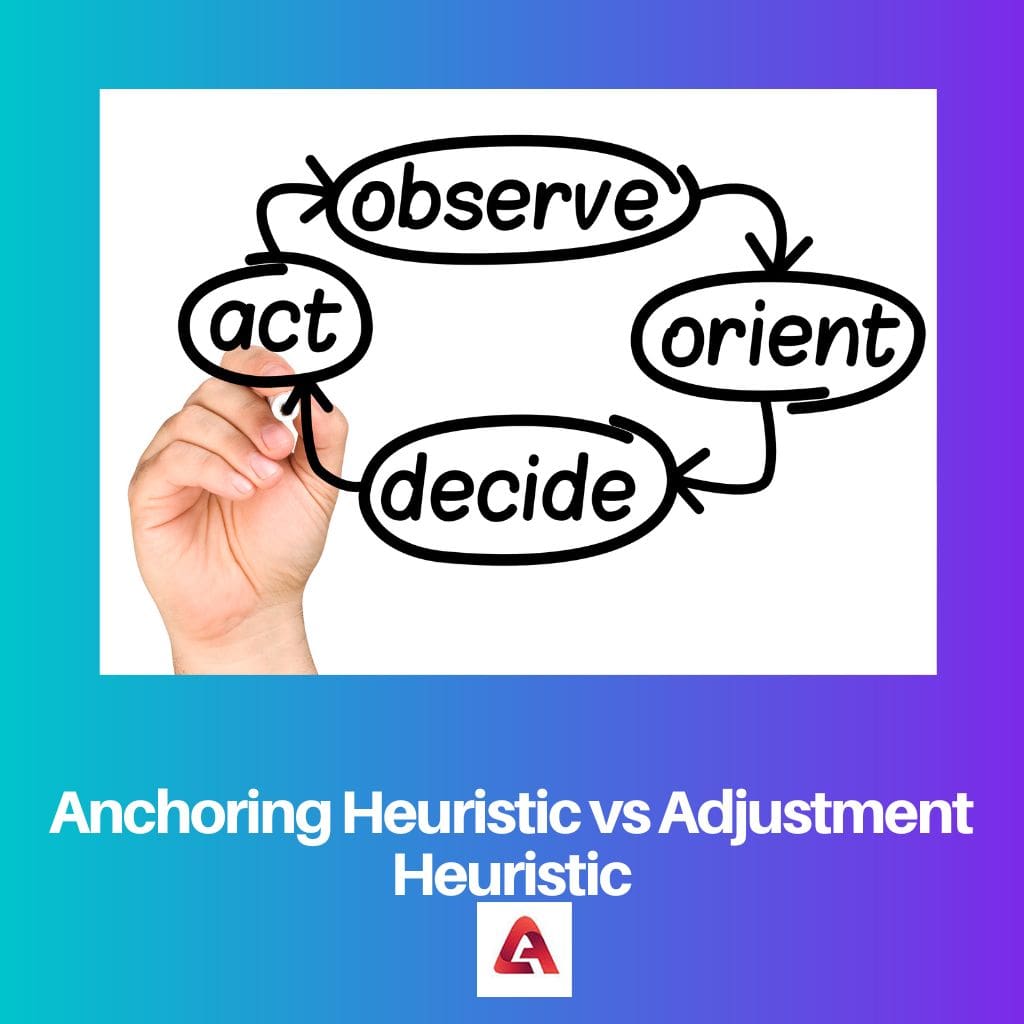The idea of a “heuristic” comes from a study by social science specialists Tversky and Kahneman.
The difference Between Anchoring Heuristics and Adjustment Heuristics let us know in depth about people’s intuitive nature and their possible actions to adjust to various situations. Learning about people’s psyches lets the experts help them.
Key Takeaways
- The anchoring heuristic involves relying on the first piece of information encountered when making decisions, while the adjustment heuristic involves adjusting initial estimates based on new information.
- Anchoring heuristics can lead to an overreliance on initial information, whereas adjustment heuristics can result in under-adjustment due to insufficient consideration of new data.
- Both heuristics are cognitive shortcuts that can result in biased decision-making and inaccurate judgments.

Anchoring Heuristic vs Adjustment Heuristic
Adjustment heuristics are referred to as mental shortcuts people use to reach to a decision and judgment based on the foremost or previously acquired information. Adjustment heuristics is referred to as a thoughtful decision of an individual after thinking and paying attention to the previously received information.
Comparison Table
| Parameter of Comparison | Anchoring Heuristic | Adjustment Heuristic |
|---|---|---|
| Definition | When you take decisions unduly based on previous experience or all information that is verified or may not maybe be verified | Adjustment Heuristic is done after establishing an anchor. This is a duly taken decision, based on an anchor. |
| Stage of Consciousness | This is a subconscious or semiconscious mind operation. People kind of execute it automatically. It looks like a pre-planned task. | This type of heuristic is conscious. People, awake and in their right mind take this decision and subsequently makes adjustment |
| Flow of Operation | People first Ankur their decision unduly based on the previously gained experience or any piece of information. | Anchor is the progenitor of the Adjustment Heuristic. Without some suit of anchor, there could be no adjustment. |
| Thought Perceptions | In this type of bias people look for results that are suitable to their cause. The plausibility may be overlooked. | In this type of bias, people make conscious decisions. The ultimate goal is to take the most economic decision that will help the cause. |
| Example | In a choice of spinning, wheel people will always go back for the highest possible number. | During salary negotiation, people might go back to the initial deal to increase their accepted-salary. |
What is Anchoring Heuristic?
Social studies experts Tversky and Kahneman came up with this idea of Anchoring, along with an Adjustment Heuristic, back in 1974.
This is used to determine the bias of decision-making for normal people. This gives us an in-depth understanding of one of the social facets of humanity.
In our everyday lives, we make a lot of decisions based on our past experiences. The decisions are so small that we do not realize them.
If the decisions were for a larger entity, then the effect would be felt on a larger scale. In that case, a decision based on some previous idea or experience may bring about unnecessary problems.
This bias is semiconscious. If it is observed, it mostly looks like the resulting process is automatic. But the decision is almost voluntary.
There is no evidence that a person makes anchors to carry on future decisions. How the process may not be from back to front but rather from front to back People later present problems with previous experiences and look forward to executing their past knowledge.
What is Adjustment Heuristic?
The Adjustment Heuristic is the proper way to bias. This is a healthy decision-making process.
In the Adjustment Heuristic, people make decisions based on an anchor that has been brought out by their previous experience. This is a conscious decision.
The beauty of this method is the adjustment process. People adjust it quite to meet the present demand or challenges.
Although the Adjustment Heuristic sounds like a more realistic bias, the anchoring university is followed on a larger scale. Every day, science, commerce, and everything else is based on it.
During COVID-19, doctors made decisions based on Anchoring Heuristics. That means decision-making based on the previous treatment. This worked well for them sometimes. However, when new complications arise rapidly, they fail to address the problem.
Main Differences Between Anchoring Heuristic and Adjustment Heuristic
- Both of the heuristics are different in their structure. Anchoring is an unduly decision progenitor, whereas the Adjustment Heuristic is adjusting decisions based on the anchor.
- Adjustment Heuristic comes out of an anchor bias. This means previously gained experience. But it is adjusted accordingly. Anchoring Heuristic does not have this luxury.
- The Anchoring Heuristic lets the person have less freedom of bias. The Adjustment Heuristic allows people more freedom of boas.
- Anchoring Heuristics can not be altered. As the name suggests, the Adjustment Heuristic can be altered as per the situation.
- Anchoring Heuristic bias makes people take questionable decisions. Adjustment bias makes people make valid decisions.
- https://journals.sagepub.com/doi/abs/10.1111/j.1467-9280.2006.01704.x
- https://www.sciencedirect.com/science/article/pii/0749597889900356
